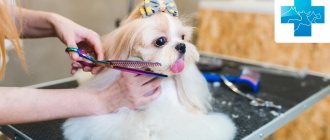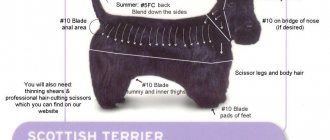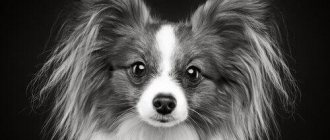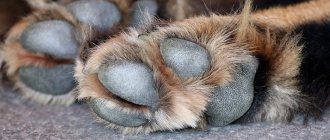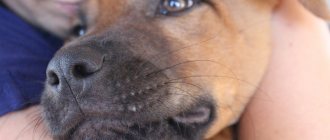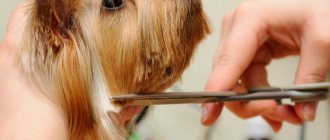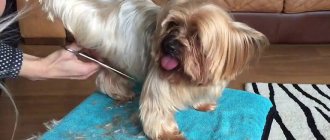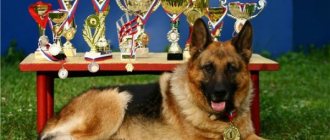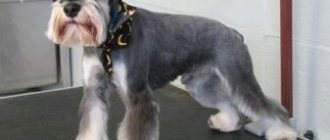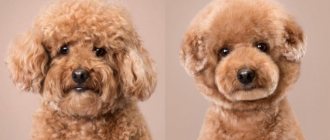Dog grooming is an integral part of grooming, mandatory care for the coat of a pet. If for some breeds this procedure is a fashionable and beautiful touch in care, then for others it is a necessary measure to ensure that the pet is healthy, cheerful and tidy.
- 1 Tools needed: dog grooming scissors and others
- 2 Preparing for a haircut
- 3 Basic haircut rules
- 4 Step-by-step instructions for grooming a dog
- 5 What precautions should you take?
- 6 What caused the need for a haircut?
- 7 What is grooming
- 8 Mr. Tail recommends: haircut or trimming
- 9 Special hairstyles for dogs by breed and class 9.1 Variety of poodle hairstyles
- 9.2 Haircuts for Bedlingtons and Kerry Blue Terriers
- 9.3 Other show haircuts
Tools needed: dog grooming scissors and others
First of all, in order to give your pet a quality haircut, you need to purchase the necessary tools and care products:
- Scissors made of high quality steel with good sharpening. It needs to be adjusted periodically. It is better to also have thinning ones with rounded ends.
- Bristle brushes, combs, slicker brushes, metal combs with frequent and rare teeth. The choice of comb depends on the breed of the dog and the quality of its coat.
- Furminator or special trimming knife.
- A mat cutting machine, most often made in the form of a nilotine.
- An electric dog hair clipper or trimmer with a set of different attachments. It is advisable to purchase a high-quality and not the cheapest model of the device, then the tool will serve for a long time. Under no circumstances should you use the one intended for humans, because the structure of the coat is completely different for humans and dogs.
- Special table for haircuts. It is necessary especially if the procedure has to be carried out frequently, sometimes once every 2-4 weeks.
- Shampoos, conditioners, lotions. They are sold in pet salons and are selected depending on the breed of the dog.
How often can you cut your dog's hair?
The frequency of haircuts is determined by the rate of hair growth, as well as the characteristics of weather conditions.
How often can you cut your dog's hair:
- The fact is that dogs with very long hair must be trimmed before the summer season. This will improve air exchange and also protect the dog from overheating.
- Under no circumstances should you cut your dog's hair very short, as this could cause harm. Thermoregulation is disrupted, the dog can freeze, or, conversely, become very overheated. There are dog breeds that need to be trimmed regularly.
- Among them it is worth noting Yorkshire terriers, poodles, and spaniels. Usually they are trimmed once every 2 months. During the haircut, the hair is shortened throughout the entire body, also on the muzzle.
- Before summer, you can radically remove the fur on the animal’s belly and paws to protect it from ticks. In some cases, a hygienic haircut is necessary, which helps the dog quickly recover from ticks and fleas.
- In this case, it is recommended to leave a short coat length and trim the dog almost completely. A hygienic haircut involves removing hair on the face, ears, beard, as well as on the paws, and in the genital area. During a hygienic haircut, the hair on the ears, face, paws, between the pads, and also in the genital area is trimmed. This makes caring for your pet easier and prevents tangles from occurring.
Doggie
Preparing for a haircut
Both the owner and the pet need to prepare for the grooming procedure.
The dog must be able to stand calmly, not be nervous, and obey. It is necessary to accustom an animal to combs and scrapers from puppyhood. You should run them over your pet’s fur several times, for example, before going for a walk or feeding, so that procedures with the fur will subsequently evoke an analogy with pleasant impressions.
Hand movements should be smooth and calm, the owner’s voice should be gentle. If your baby calmly allows himself to be combed and tangles removed, then you should introduce him to scissors. You can click them in the air several times a day in a playful way.
The puppy is also gradually accustomed to the noise of the trimmer and hair dryer. The main thing is to consolidate positive emotions, then the haircut procedure will always be easy.
It is important to choose the right place for cutting; if there is no special place, an ordinary high table or bench located under a source of good lighting will do. Both parties to the process should be comfortable throughout the entire procedure. The surface must be covered with cloth to prevent the dog's paws from slipping.
The animal's fur must be clean and prepared before shearing. Before starting the procedure, regardless of whether the owner cuts the hair himself or takes the pet to a groomer, it is necessary:
- comb out the entire coat thoroughly and remove tangles;
- bathe the dog using special shampoos and conditioners;
- dry the coat (with a hairdryer or air) and comb it.
It should be remembered that if the hair is not completely dry, you cannot cut the dog. In this case, both the quality of the haircut and the tool suffer, in addition, the risk of injuring the pet increases.
The dog won't let me cut it - what should I do?
There are dogs with dominant behavior, they try to be the leader of the pack. In this case, it is best to take your pet to the salon. The fact is that he shows dominant behavior in his home, considering himself the master.
The dog won’t let you cut it, what to do:
- The dog does not feel so confident in a foreign place, so behavior in the salon will be much calmer than in the house.
- If the dog has a dominant behavior, it can be cut at home, but for this it is necessary to perform a series of manipulations and constant work. The most interesting thing is that small breeds are the most aggressive.
- This is due to the lack of sufficient training. After all, it is with large breeds, such as a shepherd dog or a Labrador, that the dog handler’s work and training are carried out. These dogs are more disciplined and obedient.
Basic haircut rules
The procedure for grooming dogs has changed a lot from its inception to the present day, being influenced by new techniques. It now consists of the following steps:
- Removing dirt, dead hair and skin from the dog's body.
- Directly cutting, which can be done using scissors or a trimmer, or manual hair removal (trimming) using a special knife. Sometimes a combined method of cutting wool is used.
The basic rules for cutting are as follows:
- The pet must stand calmly on the surface chosen for the procedure. It should not be twisted and turned - this is the master or owner, the person who carries out the haircut must move around the animal.
- An exception is cutting the hair on the belly - in this case, it is better to put the dog on its hind legs and, carefully holding it by the front legs, shorten the hair in this area.
- The hair of all breeds is cut in the direction of growth.
- An exception to the above rule are poodles and miniature schnauzers. Their fur in the lower part of the paws must be lifted with a comb and cut against the hair growth.
- The instruments for the procedure (scissors or trimmer) move parallel to the dog’s body and can be at an angle. During the procedure, all anatomical curves of the body are repeated. The folds in the skin are stretched to prevent injury to the animal.
- Hair that is too long can never be cut in one pass. This should be done in stages, over several steps, so as not to accidentally injure your pet.
Is it possible to sharpen knives yourself?
The main working elements of any dog clipper are knives arranged in a special way.
Their sharpening is not done independently, because the task is complex and requires professionalism. On average, the service costs the owner about 500 rubles.
Dog clipper blades should always be sharp. To do this, sharpen or replace in a timely manner.
By the way, specialists always not only change parts, but also check the operation of new ones. In addition, the knives are lubricated, which significantly extends their service life.
Pair of dog clipper knives
Sharpening is carried out using special equipment. After it, the machine works like new again, performing haircuts quickly and efficiently. The service is inexpensive.
Why can't you sharpen it yourself? It's simple: knives for dog clippers have a complex shape, and if handled incorrectly, they can easily be damaged.
Sharpening is carried out using professional equipment, which eliminates the possibility of breakage.
Step-by-step instructions for grooming a dog
Before you start cutting hair, you need to clearly set the task - why the procedure is needed and what results need to be achieved: hygienic hair cutting or aesthetic haircut. Essentially, there must be a plan for the process, the required length of hair in each section must be selected.
There are many types of aesthetic haircuts, let’s look at the usual hygiene procedure as an example and describe all its stages:
- Removing excess hair under the paws (armpits).
- Treatment of the genitals and glands of the anus, removal of overgrown hair; The size of the nozzle for the machine is 4-5 mm. If scissors are used, the blades should point downward and the cuts should be vertical and parallel.
- Trimming hairs inside the ear, if necessary, and around the eye sockets.
- Some breeds, for example, poodle, Chinese Crested, require fur on their face. It is better to do this in one smooth movement, moving the scissors along one line at an angle. Then the fur must be combed and any stray hairs removed.
- Treatment of the abdominal area with careful trimming of the hair around the nipples; It is better to use a special machine; in extreme cases, carefully remove hairs with scissors.
- Removing hairs from the paw pads along a circular surface and carefully cutting them between the toes. The fur there should not be cut down to the skin.
- Processing panties on the hind legs using movements from top to bottom. The cuts must be vertical or at an angle with the required shape.
- It is better to remove the fur on the body with a machine (nozzle 3-5 mm), moving from head to tail. The side surfaces of the body are processed from top to bottom. It is advisable to leave the hair length about 2 cm.
- If you do not have experience working with a trimmer, then the fur on your pet’s chest should be trimmed using scissors.
How to care for your instrument
The dog clipper does not require complex maintenance. There are just a few rules:
- The tool should be cleaned regularly (every 5 haircuts, while allowing the machine to cool).
- Cut only washed wool, otherwise dust and dirt will clog and damage the knives.
- Use only a special brush and cleaning product.
- After cleaning, be sure to lubricate the device.
If you follow these simple rules, your dog clipper will last a long time and will more than once help turn your pet into a real beauty.
Getting a haircut again...
What precautions should you take?
When grooming a dog, especially without sufficient experience, you should be extremely careful not to injure your pet. To do this, remember that:
- You can't cut the wool completely, to zero. If there is an urgent need for this, it is better to turn to a professional.
- Particular attention is paid to pets who are not accustomed to haircuts, who are undergoing this procedure for the first time or very rarely.
- Carefully groom extremely active dogs that are unable to sit still for a minute.
- In case of injury, do not let go of the pet, confidently and calmly hold it in place, quickly treat the wound with hydrogen peroxide, Chlorhexidine or Miramistin.
- If the eyes or mucous surfaces are damaged, immediately take the animal to the nearest veterinary clinic.
How to choose the right car for your pet
First, pay attention to the reviews. Dog owners often describe the purchased devices in many different ways, so you can always immediately understand what the pros and cons of the model are.
A trained pet behaves peacefully and calmly during a haircut
Secondly, focus on the pet’s character. If he is nervous and scared, it is better to opt for silent models, the operation of which is smooth and easy.
If the dog, on the contrary, is very calm, then buy a dog clipper based on your own preferences.
Important! Consider such characteristics as the power of the device. It is she who determines what type of wool the device is suitable for. The lower the indicator, the lighter and more delicate the “fur coat” of your four-legged friend should be.
Third, use the “three dog rule.” This is what determines what device your pet needs:
- If the power is from 15 to 20 W, the machine is suitable for York type breeds;
- If the power is from 20 to 30 W, the machine is suitable for breeds such as cocker spaniel and maltese ;
- If the power is above 30W, the machine is suitable for breeds such as shepherd.
Also pay attention to functionality. Animals with coarse hair and thick undercoat require tools that have many additional capabilities.
Different haircut options for the same breed
What causes the need for a haircut?
A haircut is simply necessary for dogs with long and curly hair. Pekingese, Spitz, Poodle - these pets suffer significantly from abundant cover, especially in the hot season.
Often, pet owners believe that this procedure is too complicated and can only be carried out in special pet salons. With a little knowledge and a limited set of special tools, grooming a pet is quite accessible to a loving owner.
It is necessary to study some nuances. So, the haircut itself is suitable for dogs with soft hair, but for dogs with coarse or curly hair, special procedures are needed, which will be discussed below.
There are some peculiarities in caring for the coat of pets whose skin does not shed or whose hair falls out very little.
The main factors that prove the need for regular grooming of the coat of domestic dogs are the following:
- Shortening hair often prevents the development of irritations, skin diseases and the appearance of external parasites.
- Short hair makes it easier to clean the dog after walking outside.
- In breeds with long hair, the ear canals often become overgrown without trimming, and clusters of discharge like hair icicles accumulate inside the ear.
- In pets with special coats without timely trimming, tangles form over the entire surface of the body, which impede the ventilation of the skin, causing redness, itching and dandruff.
- A kind of haircut - trimming - is especially important for those dogs whose coat is not subject to seasonal shedding.
Why cut the wool?
Owners of long-haired pets with soft, fluffy coats know very well that trimming is not a whim, but a necessity that allows the animal to look good and feel comfortable.
Animals that are naturally endowed with lush fur need to be trimmed because:
- Ungroomed old fur dries and becomes thinner over time, and then forms into dense tangles, spoiling the appearance of the animal, preventing it from living fully and even causing pain if it forms in sensitive places, for example, on the pads of the paws.
- Overgrown fur gets stuck in the ear , causing constant itching and irritation, trapping dirt and causing diseases and even deafness.
- Overgrown hair on the face interferes with seeing , drinking and eating, that is, causing serious discomfort in everyday life.
- In the summer heat, many dogs have a very hard time because of their thick fur coat ; they easily overheat and experience increased physical and psychological discomfort.
- The owner does not have time for daily manipulation of the fur coat, combing, bathing and styling.
Almost all pets need regular hygienic shortening of their fur, and if your pet does not perform at exhibitions, then you can afford to give him an interesting haircut that will make him stand out from the crowd.
What is grooming
Grooming is part of grooming, the concept of which first appeared in the care of French poodles in the 19th century. It was then that unique haircuts for this breed appeared, for example, “Lion” or “Continental”. For the most part, these dogs were used for duck hunting, and this type of coat helped protect the dogs from hypothermia and improved their swimmer qualities. Peculiar poodle grooming salons appeared on the streets in small wooden buildings. In addition, they carried out daily pet grooming procedures.
It is interesting that the dog grooming procedure itself is to some extent copied by humans from the animals themselves. For example, breeds such as huskies or huskies are very social. In flocks, they carefully look after each other, licking their brothers’ ears, eyes, and other places that are difficult for an individual to reach, and gnawing out tangles.
It was in the 19th century in France that the concept of a groomer arose - a person caring for the appearance of a dog, and then “grooming”, which included a whole system for maintaining and adjusting the appearance of a dog. It includes bathing, cleansing the eye and ear ducts, caring for the anal glands, shortening nails, removing tartar and much more.
Today, grooming in professional pet salons includes the following mandatory set of dog care procedures:
- Bathing using special shampoos. During the procedure, previous cosmetics, dirt, particles of dead skin and lost hair are removed from the coat.
- The use of conditioners, balms, texturizing lotions, vitamin formulations for skin and coat.
- Drying and combing wool, removing tangles and fallen hairs.
- Trimming nail plates, cleaning ear and eye ducts.
- Cleansing teeth from plaque and tartar.
- Application of special preparations with antistatic and softening properties to the coat. They also prevent the formation of tangles, forming a kind of protective film on the hair.
- Corrective and/or aesthetic hair cutting of a dog.
- Special hair styling - this procedure is mostly used for show-class pets before exhibitions and competitions and is carried out using special products: talcs, mousses, gels, varnishes, and other cosmetic show products for dogs.
Professional grooming should not be confused with daily dog care. The latter is hygienic, and special care mostly solves aesthetic issues. At the same time, the pet not only acquires a beautiful appearance, the procedures help hide breed defects and bring the pet’s appearance to perfection.
Grooming procedures are slightly different for different breeds of dogs. Shorthairs and Wirehairs are usually simply brushed with a bristle brush and their coat polished with a chamois cloth. These are, for example, Labrador, Dalmatian, Beagle, Short-haired Pointer.
Medium-haired pets, such as German Shepherd, Spitz, Chow Chow, Spaniel, are combed with a hair comb. For some people, the hair is fluffed, with the brush moving against its growth. Breeds such as the Afghan Hound, Maltese, Shih Tzu, and Yorkshire Terriers are usually clipped and combed.
To train dogs, it is advisable to start these procedures at an early age. As a rule, grooming is carried out in a professional salon by experienced specialists, while the owner can learn how to perform a hygienic haircut independently.
Rating of the best cars
A convenient and very profitable option for purchasing grooming machines is to order them from Aliexpress. There is a certain rating of cars, in accordance with their technical indicators and the number of sales.
It is believed that it is best to buy machines from the following companies:
- Moser is a German brand, a leader in sales among animal clippers. The company offers vibrating and rotary options with varying power levels. The products are suitable for dogs of both large and small breeds with different coat types.
- Charge is the leader in sales among amateur-type machines. A cheap option designed for cutting wool in small areas.
- Oster is a popular American company that produces silent professional machines with a unique cooling system. Various degrees of power and different types of machines allow this brand line to be used for dogs of almost all breeds.
Mr. Tail recommends: haircut or trimming
Most often, the owner does not face such a choice and it is determined by the breed of the dog and the quality of its coat.
Dogs with long or medium-length regular hair, such as Kerry Blue Terriers, Bedlington Terriers, and Poodles, should be trimmed.
For all types of schnauzers (Riesen, Mitten, Zweng) and for griffons, dachshunds, terriers with short and rough hair, as well as for all breeds that are practically not subject to shedding, trimming has to be chosen.
“To trim” translated from English means “to trim”, “to decorate”, “to decorate”, “to put in order”. This is an expensive and painstaking job that involves manually plucking out excess hairs with your fingers.
Trimming is carried out in the same way as a haircut, not only to create an aesthetic appearance of the dog’s coat, but also for the purpose of hygienic care. Without it, the hair of these breeds will lose the necessary thickness and rigidity, and the natural texture may be disrupted.
Trimming is especially important for show-class dogs participating in exhibitions and competitions.
Some type of trimming can be called stripping. This is, in fact, an artificial change of hair in dogs that do not shed at all, the complete removal of dead undercoat. “To strip” is translated as “to strip”, “to tear off”, “to tear off”. Hair plucking is done using a special tool - a stripper.
Short-haired terriers, whose undercoat resembles barbed wire, must be stripped. It does not change naturally, but the hairs still gradually die off, ceasing their functions - they no longer protect the dog from the cold and become wet. Such hairs resemble a pin with a pointed tip located near the body. If you cut them off, the thinned part will grow back, the cover becomes soft, does not hold its shape, and fades. If you pull it out, a new hair will grow in its place, which will again be hard and elastic.
Such dogs are stripped almost completely; only small areas around the anus and genitals are trimmed with scissors or clippers.
When stripping or trimming, all preparatory procedures are carried out, as before cutting. The dog is thoroughly combed and matted areas of fur are untangled. It is advisable to bathe not before, but after removing the undercoat. Then the pet is placed on a special table and fastened by the collar to the provided holder. The hairs are removed by disassembling them into small bundles, pressed with your thumb to the blade of a stripping or trimming knife and pulled out. The tool is always positioned at right angles to the fur. Movements should be strong and confident, sharp, directed towards hair growth. While the right hand is working with the tool, the left hand should hold the skin a little higher to prevent the pet from feeling pain.
A trimming or stripping knife is a blade with a rounded end and serrations. It does not cut hairs, but holds them and helps remove them.
During the procedure, the fur is removed in several stages evenly throughout the body. After the procedure, the pet is thoroughly combed, removing tangled and unfallen hairs.
It is important not to carry out this procedure ahead of time. It is necessary to wait for the undercoat to fully mature; if you pluck the hair before this, you can injure the skin.
Useful tips
You shouldn’t cut your dog’s hair too short, as the fur serves not only an aesthetic function, but also a protective one. Without the required length of hair, the animal may freeze or overheat. Insufficiently protected skin is susceptible to injury, parasite bites, scratching, and inflammation.
If you doubt your abilities or your pet is a show-class dog taking part in exhibitions, attend several master classes where they will tell you and clearly show you how to cut a dog’s hair at home. Thus, by avoiding unnecessary stress for the animal, you can save considerable amounts on show grooming. Regular grooming and a good haircut will help maintain a beautiful, healthy coat and excellent appearance for your pet.
Special hairstyles for dogs by breed and class
The structure of the fur of dogs of different breeds is different. Groomers conventionally divide pets into soft- and hard-haired, shedding and non-shedding. Depending on the type of coat, there are also hairstyles for four-legged pets.
In dogs with soft and long hair, hair grows faster and the frequency of the procedure is higher; it must be performed at least once every 2-4 weeks. Coarse hair grows slower and can be cut once every one and a half to two months.
Fashionable hairstyles for dogs do not change as radically as for people, although some details have changed significantly over time. Owners of show pets should especially monitor new trends if they participate in exhibitions and competitions.
Variety of poodle hairstyles
The most varied and numerous types of haircuts probably exist for all varieties of poodles. Their long, curly fur allows them to model their hairs, giving them a variety of shapes and styles. The classic style is the lion haircut, while all the others are considered modern styles.
They usually start with a puppy hairstyle - in this case, very short fur remains on the limbs and face, and a kind of cap is formed on the head.
Previously, fashion for poodles required them to maintain a “beard” and “mustache.” Nowadays it is customary to trim the fur on the face very short. The hat is designed in various designs. It can separate from the ears and look like a crown.
According to the classic style on the upper part of the body, a poodle's hairstyle is more voluminous; the chest and neck are not separated from each other, which is why the pet resembles a lion after a haircut. The limbs are cut very short, only balls or spirals of pom-poms remain at the feet. It is also possible to preserve the “pants”.
Modern poodle hairstyles are varied. Usually, the hair on the body and neck is cut short, forming various images, only always retaining the ball at the tip of the tail.
Perhaps, only a very rare breed of poodles, the corded one, is not completely clipped. Their fur in the form of long cords is carefully laid out over the body, forming only the hairs on the muzzle.
Bedlington and Kerry Blue Terrier haircuts
Also interesting are the hairstyles of two breeds of terriers - Bedlingtons and Kerry Blues.
Bedlingtons have soft, light-colored fur. It is formed with scissors or a machine. After the procedure, the pet looks like a charming lamb with a tuft on its forehead and soft tufts on its ears.
The Kerry Blue Terrier has a long muzzle, forming a fringe, beard and mustache on it. The bottom of the neck, cheeks, forehead and ears are usually cut short. The hair on the body is of different lengths, the transitions are very smooth. On the one hand, the emphasis is placed on a slender body, on the other hand, they give it angular shapes.
Other show haircuts
Today, the following hairstyles are most common in grooming salons for show-class dogs:
- Flat-cuts involve uniform trimming of the pet's fur throughout the body; there are varieties of haircuts depending on breed.
- Clipper eyelids – provide for the fact that a very short coat of hair remains on the dog’s body. The procedure is carried out only with a machine with a short nozzle.
- Showstreams include a wide variety of haircuts for different breeds. These are comprehensive professional hairstyles for show animals.
- Blendings are dog hairstyles formed with thinning scissors.
- Topnots are frivolous haircuts with a variety of accessories - bows, hairpins, elastic bands, combs. They are most often used for decorative small and very small dogs.
Tools used
To ensure a quality haircut, you need to arm yourself with scissors and a clipper. Cheap cars make a lot of noise, which can scare your pet. Moreover, such a machine always produces strong vibration. If a dog has too thick a coat, matted areas often form. In such cases, you can use a tangle cutter and a comb.
The wedge cutter can be:
- Vertical. It is shaped like a comb with curved but sharp teeth.
- Horizontal. The cutter is sharpened on one side and rounded on the other.
- Drop-shaped. This is a pocket-sized tool that can be used for shallow cutting.
The dog and its owner should be comfortable and comfortable. The surface must be stable and level. Otherwise, you can injure your hands and injure your pet.
Salon or DIY haircut at home
If the pet has soft and quickly growing fur, then it would be advisable for the owner to learn at least the simplest hygienic haircut in order to do it himself. This will make life much easier for both the pet and the household, and will also help the dog maintain excellent health and beautiful, shiny hair.
In cases where pets lead an active show life, especially if their career is taking off, it is better to choose a permanent groomer and not engage in amateur activities. After all, one wrong move can ruin a dog’s appearance for several months.
You can experiment to your heart's content with decorative pets, especially long-haired breeds. There are known cases when skillful and caring owners turned a Yorkie into a Chinese Crested dog with the help of scissors and trimmers, and a Pekingese became a small lion cub.
It should be remembered that creating hairstyles must be done in these cases regularly, sometimes twice a month, and this is not a cheap pleasure, regardless of whether they are done at home or in a salon. The cost of procedures from professional groomers, depending on the breed, size of the dog, complex and complexity of the procedures, varies from 1,500 to 15,000 rubles.
Therefore, many, when choosing a future pet, give preference to breeds that can do without haircuts at all, or this procedure is possible 3-4 times a year. At the same time, if you learn how to groom your pet and carry out this procedure yourself, you can save a lot. All you need is love and patience.
Possible difficulties
The theory is clear, but in practice everything may not be so smooth. It is especially difficult to predict the behavior of an adult dog that has never been groomed. Not every animal likes this process - it may be scared, and some become aggressive out of fear and try to bite the groomer. You need to be able to control the dog and finish what you started in any case.
If the animal behaves aggressively
An aggressive and angry dog also needs someone to cut its hair. Some growl and bite out of fear, some out of a bad temper, but there are several ways to deal with them.
Firstly, an aggressive animal behaves more quietly with strangers, so it is better to go to the groomer the first couple of times so that the dog understands that nothing bad is happening. Try to calm the animal, but if it still tries to bite, it is better to put on a muzzle and continue with your business.
In extremely severe cases, the groomer can offer sedation - this is an effective method, but you should not experiment on your own, since the dose of the sedative must be carefully calculated.
If the animal is very scared
A frightened dog needs to be calmed first. Talk to him quietly and confidently, because the owner’s fear and anxiety is transmitted to the dog. Let her get comfortable and smell the tools.
Try gently scratching your neck and letting him know that it's not a big deal. If you are afraid of a hairdryer, then do not dry the animal: wash it the day before and let it dry naturally. Choose a machine that is as silent as possible - many four-legged animals are afraid of an incomprehensible buzzing sound. Sometimes sedation is a solution in this case too.
If your pet hasn't been groomed for a long time
If your pet's hair is cut irregularly, the combs are taken out once a year - this is an unusual procedure for him. Often the friend is not only shaggy, but also covered in tangles.
If the poor animal looks like a felt boot, then the easiest option would be to shave it to a minimum length. Sometimes groomers spend 8-10 hours on neglected clients to leave them in coat, and of course, this is a lot of stress for both the master and the ward.
